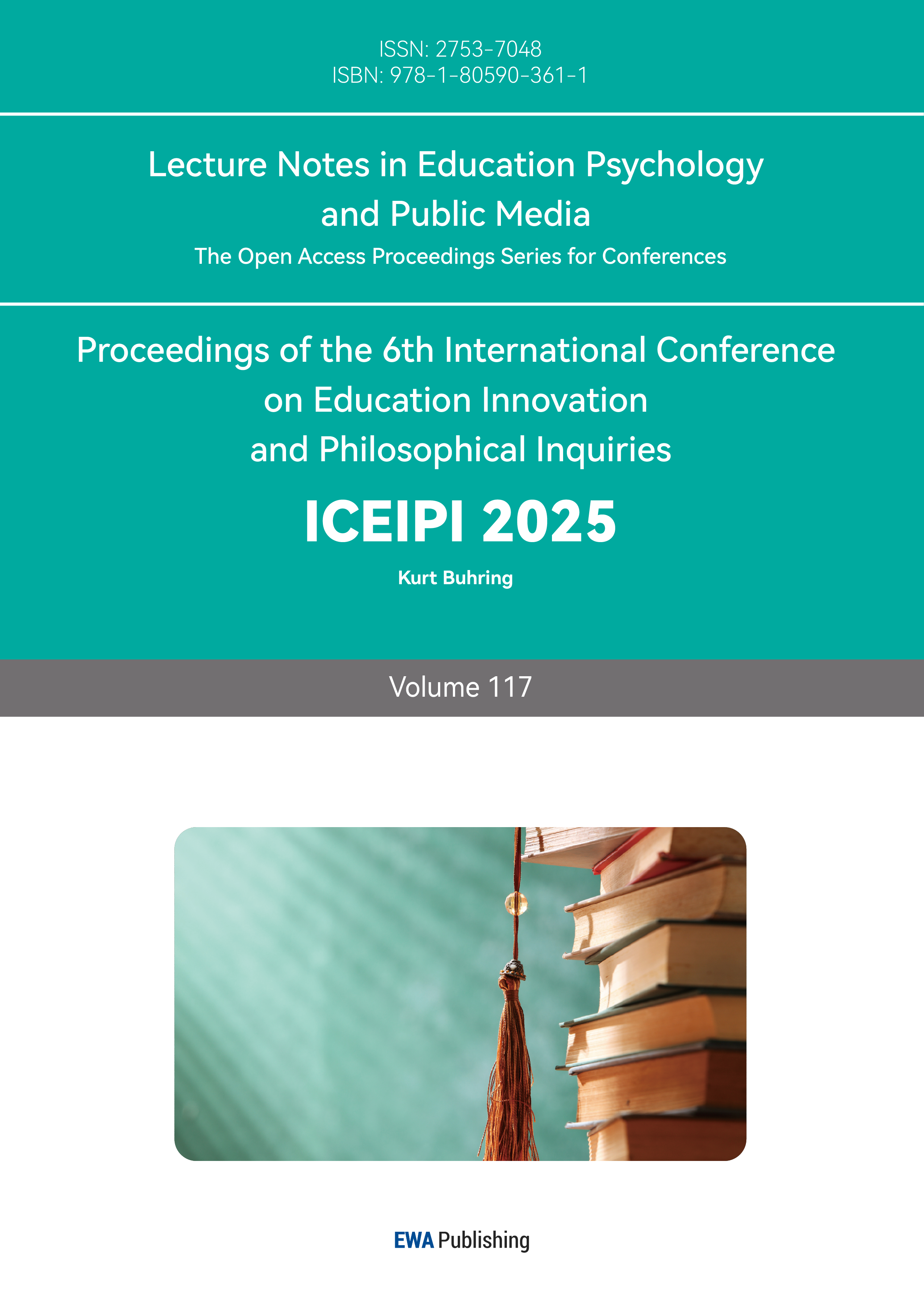1. Introduction
As an internationally recognised form of interdisciplinary education, STEM education is becoming increasingly evident for its interdisciplinary problem-solving capabilities. With the rapid development of technologies such as the Internet, 5G technology and artificial intelligence, STEM education is also an opportunity for collaborative human-machine teaching [1]. STEM education originated in the United States and has been developed over the past 30 years. It has gradually become a strategic choice for countries around the world to implement new changes in education in the 21st century [2-3]. With the global spread of STEM education, China has also made use of the opportunity of innovation and entrepreneurship to make STEM education flourish, and has made great progress in terms of theoretical research, educational application practices and related science and technology policies [4-5], although there are also problems and challenges. This study takes advantage of the bibliometric method to visualise and measure the literature in a specific field. The aim is to track and analyse the research trends and directions of STEM education in China, explore and find the frontiers of research, in order to provide some reference for further research and localised practical application of STEM education in China. In addition, it reveals the current research status and research hotspots of STEM education in China, as well as forward-looking recommendations, with a view to providing data references for international STEM education.
2. Data sources and study design
2.1. Data sources
In order to ensure the authority of the literature and the reliability of the data sources, the Peking University core journals and CSSCI journals in China Knowledge Network (CNKI) were used as the data sources for this study. In addition, in order to ensure the comprehensiveness of the literature, we searched the literature with “STEM education” or “STEAM education” as the theme, title and keywords, and searched the literature collected from January 1, 2012 to August 19, 2025(because the research on STEM education in China started to develop after 2012(China Academy of Educational Sciences, 2012) [4], so the search The study was based on these 1011 Chinese literatures. This study uses these 1011 Chinese literature as the research sample to conduct bibliometric statistics and visual analysis of STEM education research in China based on the Internet and artificial intelligence.
2.2. Research methodology and tools
CiteSpace is a visual analysis tool developed by Professor Chao-Mei Chen, a Chinese-American scholar at Drexel University in the USA, which combines the principles of co-citation analysis and pathfinding network algorithms [6-7] to present the evolution of knowledge domains in a It is designed to represent the evolution of the knowledge domain on a network map, and to characterise the research hotspots and frontiers in a co-occurrence knowledge map [8]. In view of this, this study uses CiteSpace (version 6.3.R1) to create a visual knowledge map to collate and analyse research results on STEM education in China, with a view to revealing the current status, hot spots and development trends of STEM education research in China in a more objective manner.
3. The general state of STEM education research
3.1. Distribution of the number of STEM education research papers
The number of research papers published can present the evolution and development of research results in the research field, revealing the trends and hotness of the field.
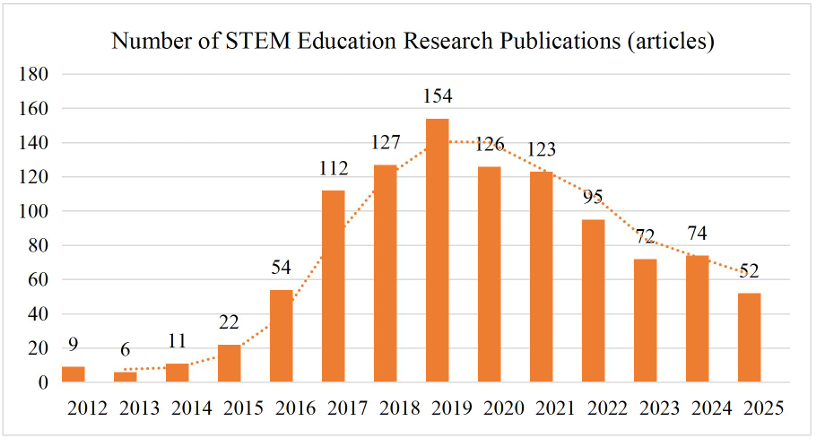
The statistics of the 1011 valid papers collected according to time distribution (Figure 1) reveal that: the year 2019 is the watershed year for STEM education research, and the number of studies from 2012 to 2019 shows a steady upward trend. From 2015 to 2019, STEM education research explodes, research content deepens, and STEM education receives increasing attention from scholars; from 2020 to 2025, although the number of publications is weak, even with the incomplete number of publications in 2025, the average annual volume of literature in this period reaches 90. This indicates that STEM education research in China has entered a phase of rapid development and is becoming a hot spot for scholars.
3.2. Analysis of the number of core author publications and collaborative networks
The development of STEM education research cannot be achieved without a core of researchers with a significant number of publications and scholarly research capabilities, so core authors need to be examined in terms of indicators such as author publications and author collaboration analysis. According to Price’s law and Locat’s law, the core authors can be identified by
Using CiteSpace (Author module) to analyse the collaboration of posting authors and plotting to form an author collaboration network map (Figure 2), the distribution and collaboration of core authors in STEM education can be obtained. In terms of author collaboration networks, eight research teams have basically formed in the field of STEM education research in China. These research teams are mostly colleagues from the same institution, with less inter-institutional and interdisciplinary collaboration. There are also many independent authors outside the core authors, some of whom have collaborated on a single occasion, but the collaborations are fragmented and do not form a team.
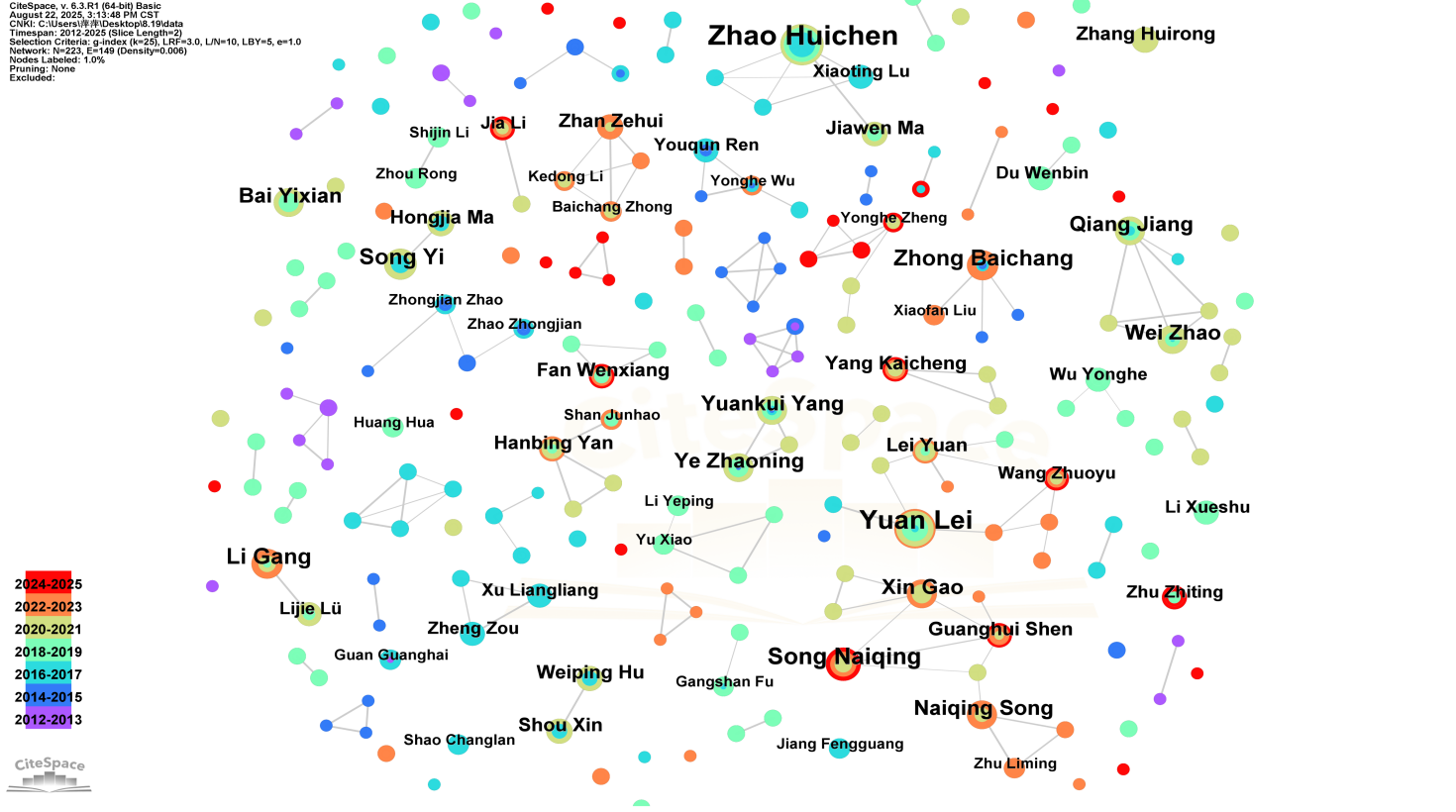
(Note: the brighter the colour and the thicker the line, the more collaborative the study author.)
4. Hot topics in STEM education research
Knowing the research hotspots and research themes of a research field can plan future research directions. Therefore, through the analysis of keyword word frequency and co-occurrence clustering analysis, the hot topics of STEM education research in China can be further explored [9].
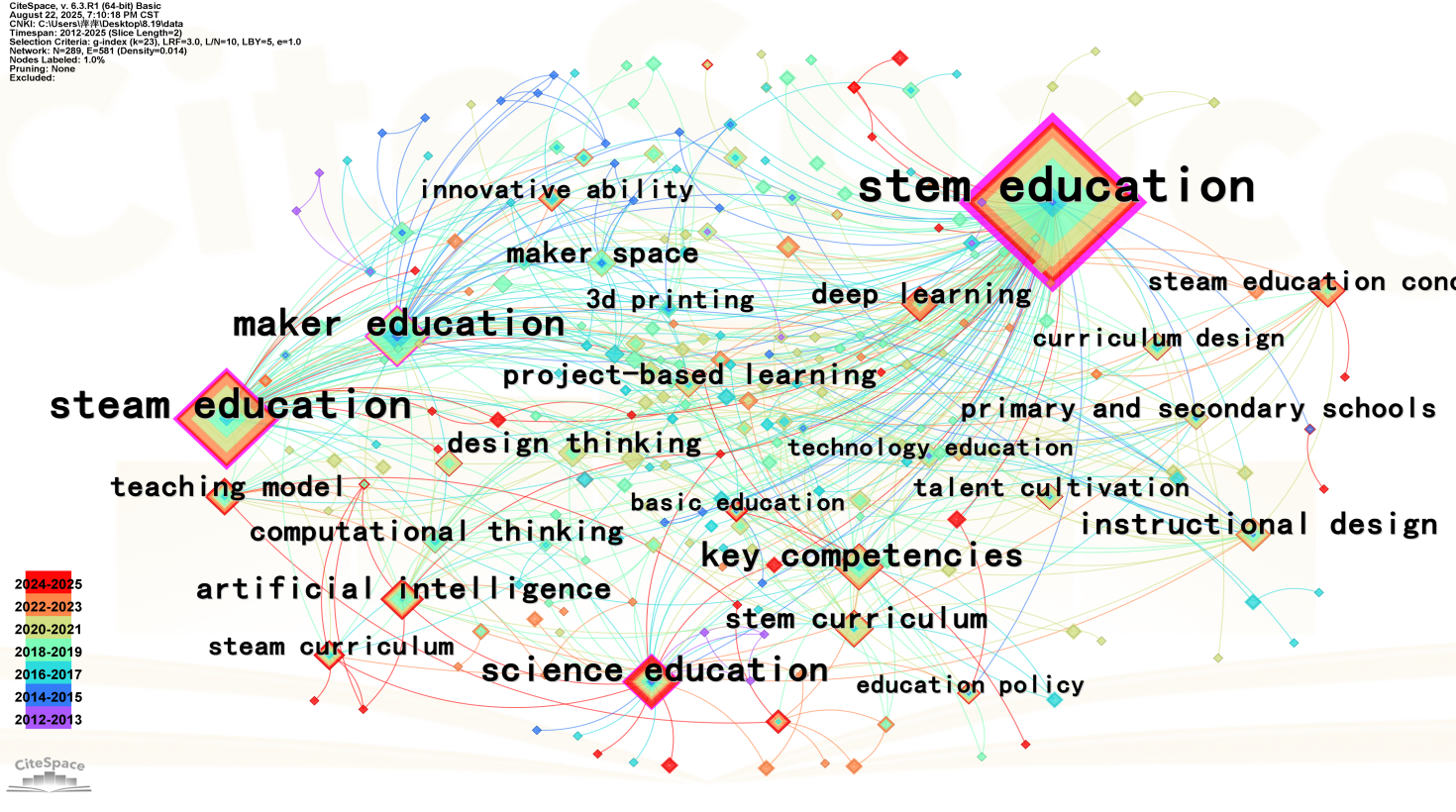
4.1. Keyword word frequency and co-occurrence analysis
Keywords are a high level summary of the research topic of an article, and with the help of keyword word frequency analysis, the research hotspots and development trends of the research field can be obtained. CiteSpace (Keyword module) was used to analyse the keyword frequency statistics, with the annual interval of 2012-2025, the density between nodes was 0.014. The top 24 most frequent keywords were extracted according to their frequency, forming Hot topic words in the field of STEM education research in China from 2012 to 2025, plotted to form a co-occurrence map of research topic words (Figure 3).
It can be seen that the current research in this field is mainly focused on STEM education, involving the research of STEM, science education, artificial intelligence, steam education, interdisciplinary, design thinking and other branches in the United States.
4.2. Keyword clustering analysis
After word frequency and co-occurrence analysis of keywords to obtain hot topics, clustering analysis can be performed to obtain research hotspots in STEM education. Keyword clustering was performed in CiteSpace and the effect of the clustering map was judged by the module value Q and the average profile value S1 based on the network structure and the clarity of the clusters. After selecting pathfinder analysis, only the top 10 clustering labels were retained to improve the readability of the map, which was drawn to form a clustering map of STEM education research (Figure 4). The clustering atlas showed that the Q value = 0.5172>0.3, indicating a significant delineated association structure, and the S value = 0.8659>0.7, indicating that the clustering was efficient and convincing. The STEM education cluster mapping therefore delineates associations with significant structure and good clustering, and is able to reveal development hotspots from the overall characteristics of STEM education research.
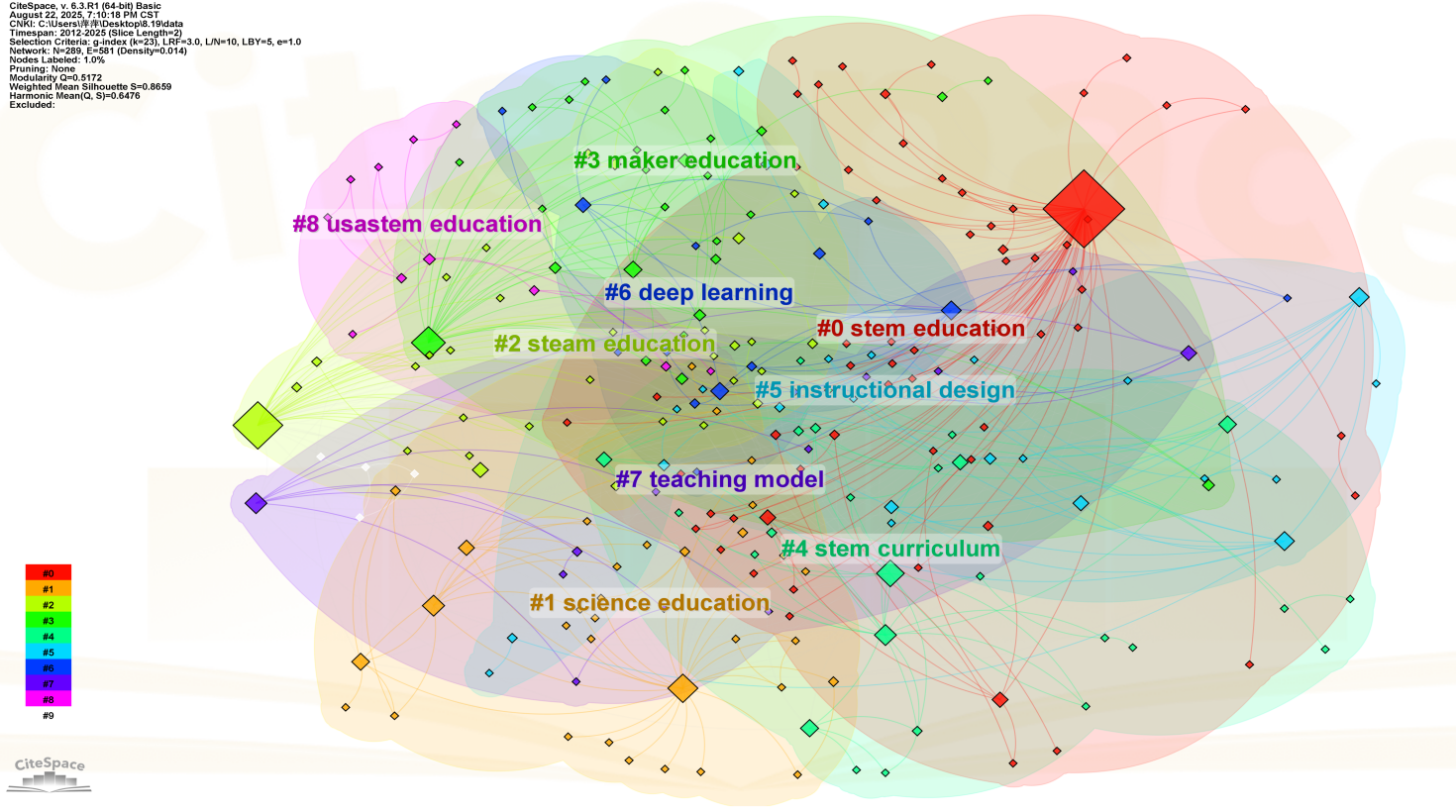
In Figure 4, the ten main clusters are: #0 stem education, #1science education, #2 steam education, #3 maker education, #4 stem curriculum, #5 instructional design, #6 deep learning, #7 teaching model, #8 USA, and #9 key competencies. By organizing the cluster information (Table 1), it can be found that “stem education” is the largest cluster, which indicates that stem education research embodies the STEM education concept. The clusters with the highest cluster efficiency are “key competencies”,“USA”,“stem education” and “stem curriculum”. As can be seen from Table 1, most of the clusters were born in 2016-2018 and 2019-2020, which correspond to two “active periods” of STEM education research in China, during which the research scope gradually gathered and research results began to be abundant.
Using the clustering information aggregation function provided by CiteSpace and the content of the clustered class clusters, the 10 main keywords can be clustered into three major hot topics of STEM education research. The three hot themes cover focus on STEM education philosophy and education policy (#0 stem education, #2 steam education, #8 USA), focus on curriculum design (#1 science education, #3 maker education, #4 stem curriculum, #5 instructional design, #6 deep learning, #7 teaching model), and focus on STEM literacy (#9 key competencies).
|
Subject Number |
Cluster Number |
Cluster Name |
Silhouette Degree |
Clustering Size |
Average year |
|
1 |
#0 |
stem education |
0.928 |
61 |
2018 |
|
#2 |
steam education |
0.64 |
32 |
2019 |
|
|
#8 |
USA |
0.942 |
11 |
2015 |
|
|
2 |
#1 |
science education |
0.897 |
33 |
2018 |
|
#3 |
maker education |
0.899 |
27 |
2016 |
|
|
#4 |
stem curriculum |
0.925 |
26 |
2017 |
|
|
#5 |
instructional design |
0.815 |
24 |
2019 |
|
|
#6 |
deep learning |
0.819 |
15 |
2018 |
|
|
#7 |
teaching model |
0.91 |
12 |
2019 |
|
|
3 |
#9 |
key competencies |
0.997 |
4 |
2020 |
5. Research trends in STEM education
With the time variable as the horizontal axis and the cluster name and number as the vertical axis, CiteSpace can be plotted into a cluster timeline mapping, showing the historical trajectory and time span of each cluster theme, which provides a reference for us to study the evolutionary path of each theme [10]. Based on the keyword timeline mapping, the research on STEM education in China from 2012-2023 can be divided into three phases:
Phase 1: The beginning of STEM education research (2012-2014). The number of STEM education research literature in this phase is relatively small, involving fewer subject terms and clusters, mainly related to STEM education, the United States, technology education and science education, and other subject terms and clusters have not yet been generated. The relevant articles mainly focus on topics such as STEM education philosophy, STEM education in the US and changes in education policies, which are positive guides for subsequent STEM education research.
Phase 2: The development period of STEM education research (2015-2019). The number of STEM education research literature in this stage has grown explosively compared to the nascent stage, involving more subject terms and clusters, and most high-frequency subject terms have been revealed in this stage. Relevant articles mainly focus on creative education, creative spaces, interdisciplinarity, project-based learning, artificial intelligence, computational thinking, core literacy and curriculum design, which have an important leading role in subsequent STEM education research.
Phase 3: The consolidation period of STEM education research (2019-2025). The number of STEM education research literature in this phase decreases compared to the previous phase but the average annual number of publications is still high, and new themes emerge from the existing themes, such as integration, deep learning, knowledge construction, innovation ability, knowledge graph,and learning progression.
6. Research findings
This study based on the Internet The current situation, hot topics and development trends of STEM education research in China were discussed based on the Internet and artificial intelligence, and the following conclusions can be obtained:
First, in terms of the overall research trend, the wide range of sources of research papers published in journals and the high number of papers indicate that STEM education research in China is currently showing rapid development, with a new research high in 2019. It is evident that Chinese STEM education research is gradually maturing, and the future STEM education research fever will also be in a period of academic prosperity.
Secondly, from the co-occurrence map of core authors and research institutions, a core author research team has basically been formed for STEM education research in China, but the density of author and research institution cooperation network is low and the cooperation network is relatively scattered, indicating the lack of academic links between research authors and between research institutions. Teacher training colleges and universities are currently the main site of STEM education research, but further strengthening of the integration of theory and practice is needed.
Thirdly, from the keyword co-occurrence mapping, the more frequent subject terms are “stem education”, “steam education”, “United States”, “science education”, “maker education”, and “key competencies”, etc. Based on the keyword cluster analysis mapping, the three hot topics of STEM education research in China are sorted out: STEM education philosophy and education policy, STEM curriculum design and STEM literacy.
Fourth, the keyword timeline mapping and keyword emergence mapping reveal the development trend of STEM education research in China, and can be categorised into the starting period (2012-2016), the development period (2016-2019) and the consolidation period (2019 -2025). In addition, the analysis of timeline mapping and keyword emergence mapping summarises the next frontier directions of STEM education research development for reference in the next relevant research.
7. Conclusion
Against the backdrop of the "Double Reduction" policy, China has entered a new era of educational reform and quality-oriented education. Leveraging STEM education to further enhance students' awareness of innovative thinking and their literacy in solving interdisciplinary problems is also an effective way to promote educational reform.
First, we should continue to focus on the specific practices of STEM education in China, summarize the beneficial experiences gained in the process of STEM education practice, extract the "local experiences" in the implementation of STEM education, and enrich the theoretical research on STEM education. It is worthy of great attention from the academic community and researchers to integrate the concept of STEM education into basic education teaching and even higher education, which serves as the source of basic education teachers.
Second, attention should be paid to the integration of STEM literacy and the design of STEM courses. Currently, in basic education, STEM concepts are mainly integrated into science courses. However, STEM is inherently interdisciplinary. Therefore, it is suggested that the STEM education curriculum be reconstructed in basic education.
Third, it is necessary to strengthen interdisciplinary collaboration and cooperative research among institutions. STEM education involves the interdisciplinary integration of Science, Technology, Engineering, Mathematics and other disciplines. It is recommended that researchers with different disciplinary backgrounds form research teams to enhance cooperation and communication. In addition, with the continuous advancement of STEM education practice, the implementation of specific STEM education practices requires researchers who have a good command of both disciplinary knowledge and STEM concepts. Therefore, it is suggested to strengthen the exchange and cooperation between scholars with different disciplinary backgrounds and different institutions to jointly promote the development of STEM education research.
Funding
This paper is part of the research results of the 2025 Yunnan Provincial Undergraduate Colleges Artificial Intelligence Empowering Basic Course Teaching Reform Research Project "Intensive Construction and Practice of Multimodal Textbooks for University Knowledge and Ability-oriented General Courses Based on AI Agents", and the 2025 School-level Teaching Reform Project "Intensive Construction and Practice of Multimodal Learning Resources for Knowledge and Ability-oriented Courses in Local Colleges and Universities" (Project No.: 202528).
References
[1]. Fu Qian, Liu Pengfei. From Verification to Creation—A Research on STEM Education Performance Models in Middle and Primary Schools. China Educational Technology, (4), 2016.p.71-78.
[2]. Zhu Zhiting, Lei Yunhe. An Analysis of National Policies and Practical Models for STEM Education. e-Education Research, (1), 2018.p.75-85.
[3]. Du Wenbin. Analysis of Main Topics and Characteristics of STEM Education Studies Abroad. e-Education Research, (11), 2018.p.120-128.
[4]. China Academy of Educational Sciences. White paper on STEM education in China (essence edition) [R]. Beijing: China Academy of Education Sciences, 2017.
[5]. STEM Education Research Centre, China Academy of Textbooks. Research report on STEM education in China (brief version). Beijing China, STEM Education Research Center of China Academy of Textbooks, 2019.10.
[6]. Li Xinguan, Wei Shuyan, Liu Dongmei. Hot topics and evolutionary trends of digital governance research in China. Southeast Academic, (02), 2022. p.61-71+247.
[7]. Chen Yue, Chen Chaomei, Hu Zhigang, Wang Xianwen. Principles and Applications of Analyzing a Citation Space. Beijing China, Science Press, 2014.
[8]. CHEN C, CHEN Y, HOROWITZ M, et al. Towards an explanatory and computational theory of scientific discovery. Journal of Informatics, 3(3), 2009.p.191-209.
[9]. Chen Yue, Chen Chaomei, Liu Zeyuan et al.The methodology function of CiteSpace mapping knowledge domains. Studies in Science of Science, (2), 2015. p. 242-253.
[10]. Li Jie, Chen Chaomei. CiteSpace: Text Mining and Visualization in Scientific Literature (Second Edition). Beijing China: Capital University of Economics and Trade Press, 2017.
Cite this article
Gong,P. (2025). The Current Situation, Hot Spots and Trends Analysis of STEM Education Research in China Based on Internet and Artificial Intelligence. Lecture Notes in Education Psychology and Public Media,117,22-29.
Data availability
The datasets used and/or analyzed during the current study will be available from the authors upon reasonable request.
Disclaimer/Publisher's Note
The statements, opinions and data contained in all publications are solely those of the individual author(s) and contributor(s) and not of EWA Publishing and/or the editor(s). EWA Publishing and/or the editor(s) disclaim responsibility for any injury to people or property resulting from any ideas, methods, instructions or products referred to in the content.
About volume
Volume title: Proceedings of the 6th International Conference on Educational Innovation and Psychological Insights
© 2024 by the author(s). Licensee EWA Publishing, Oxford, UK. This article is an open access article distributed under the terms and
conditions of the Creative Commons Attribution (CC BY) license. Authors who
publish this series agree to the following terms:
1. Authors retain copyright and grant the series right of first publication with the work simultaneously licensed under a Creative Commons
Attribution License that allows others to share the work with an acknowledgment of the work's authorship and initial publication in this
series.
2. Authors are able to enter into separate, additional contractual arrangements for the non-exclusive distribution of the series's published
version of the work (e.g., post it to an institutional repository or publish it in a book), with an acknowledgment of its initial
publication in this series.
3. Authors are permitted and encouraged to post their work online (e.g., in institutional repositories or on their website) prior to and
during the submission process, as it can lead to productive exchanges, as well as earlier and greater citation of published work (See
Open access policy for details).
References
[1]. Fu Qian, Liu Pengfei. From Verification to Creation—A Research on STEM Education Performance Models in Middle and Primary Schools. China Educational Technology, (4), 2016.p.71-78.
[2]. Zhu Zhiting, Lei Yunhe. An Analysis of National Policies and Practical Models for STEM Education. e-Education Research, (1), 2018.p.75-85.
[3]. Du Wenbin. Analysis of Main Topics and Characteristics of STEM Education Studies Abroad. e-Education Research, (11), 2018.p.120-128.
[4]. China Academy of Educational Sciences. White paper on STEM education in China (essence edition) [R]. Beijing: China Academy of Education Sciences, 2017.
[5]. STEM Education Research Centre, China Academy of Textbooks. Research report on STEM education in China (brief version). Beijing China, STEM Education Research Center of China Academy of Textbooks, 2019.10.
[6]. Li Xinguan, Wei Shuyan, Liu Dongmei. Hot topics and evolutionary trends of digital governance research in China. Southeast Academic, (02), 2022. p.61-71+247.
[7]. Chen Yue, Chen Chaomei, Hu Zhigang, Wang Xianwen. Principles and Applications of Analyzing a Citation Space. Beijing China, Science Press, 2014.
[8]. CHEN C, CHEN Y, HOROWITZ M, et al. Towards an explanatory and computational theory of scientific discovery. Journal of Informatics, 3(3), 2009.p.191-209.
[9]. Chen Yue, Chen Chaomei, Liu Zeyuan et al.The methodology function of CiteSpace mapping knowledge domains. Studies in Science of Science, (2), 2015. p. 242-253.
[10]. Li Jie, Chen Chaomei. CiteSpace: Text Mining and Visualization in Scientific Literature (Second Edition). Beijing China: Capital University of Economics and Trade Press, 2017.





